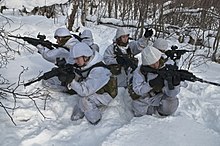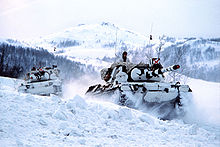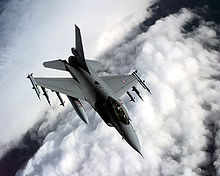Norwegian Armed Forces
|
|||
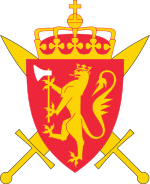
|
|||
| guide | |||
|---|---|---|---|
| Commander in Chief : | King of Norway , currently King Harald V. | ||
| Defense Minister: | Frank Bakke-Jensen | ||
| Military Commander: | Major General Eirik Johan Kristoffersen | ||
| Military leadership: | The "United High Command" | ||
| Headquarters: | Oslo | ||
| Military strength | |||
| Active soldiers: | 20,000 (2019) | ||
| Reservists: | up to 140,000 | ||
| Conscription: | 19 months, of which 12 months with active service | ||
| Eligibility for military service: | Between 19 and 44 years of age | ||
| household | |||
| Military budget: | $ 7.179 billion (2019) | ||
| Share of gross domestic product : | 1.7% (2019) | ||
| history | |||
| Founding: | 1905 | ||
The Norwegian Armed Forces ( Norwegian Forsvaret , "defense") are responsible for the military defense organization in Norway . They consist of four branches of the armed forces , the army , the navy , which the Coast Guard with covers, the Air Force (Luftforsvaret) , the militia-like organized Home Guard (Heimevernet) and various other joint authorities.
Strength and organization
The peacekeeping strength of the entire armed forces of Norway is around 18,000 active soldiers . There are also around 5,000 civilian employees. When mobilized , the total rises to around 83,000. 50,000 of them are members of the Home Guard. In addition, up to 140,000 reservists are available.
In Norway there is compulsory military service for all men and women from the age of 19, the service period is currently twelve months. Of the 63,841 women and men who were drafted in 2012, 9,256 men were drafted. Since 2009 women have also been obliged to be examined , but military service remains voluntary. The proportion of women in 2009 was around 7%. On June 14, 2013, the Norwegian Parliament passed a resolution to make conscription also valid for women from 2015, making Norway the first NATO member and the first European country where conscription applies to both sexes. In October 2014, Parliament passed a change in the law, according to which from 2015 all young people can be convened. Conscripts women were first in the summer of 2016 convened . According to Defense Minister Ine Eriksen Soreide, the goal is to increase the proportion of women; the total number of soldiers should remain the same.
The nominal commander-in-chief of the Norwegian armed forces is the respective King of Norway , currently King Harald V. However , the military is led by the incumbent defense minister and a chief of staff ( Forsvarssjefen ) in an advisory capacity. The "United High Command" of the Norwegian Armed Forces is located in Stavanger and the Krigsskolen Military Academy in Oslo .
General structure
The Norwegian Armed Forces are officially called simply "The Defense" ( Forsvaret ). According to the Norwegian Constitution, the King is its Supreme Commander. In principle, Norway is a constitutional kingdom. The parliament and the government are responsible for defense policy. The current frameworks for the defense sector as of January 1, 2017 are as follows:
Kingdom of Norway ( Staten )
- Norwegian Parliament ( Stortinget )
- Norwegian Government ( Regjering , headed by the Prime Minister ( Statsministeren ))
- Defense Department ( Forsvarsdepartementet headed by the Defense Minister ( Forsvarsministeren ))
- Military Organization of Defense ( Forsvarets militære organisasjon )
- Cyber defense ( Cyberforsvaret , branch of the armed forces, led by a major general / rear admiral )
- Reconnaissance Service ( Etterretningstjenesten , led by a Lieutenant General / Vice Admiral , plays the roles of both State and Military Reconnaissance Service )
- Defense Military Geographic Service ( Forsvarets militærgeografiske tjeneste )
- College of Defense [Military Academy] ( Forsvarets høgskole , run by a major general / rear admiral )
- Defense Staff School ( Forsvarets stabsskole )
- Defense Education College ( Forsvarets etterretningshøgskole )
- Distance Learning Department of Defense ( Forsvarets fjernundervisning )
- Institute for Defense Studies ( Institutt for forsvarsstudier )
- Defense logistics organization ( Forsvarets logistikk organisasjon integrated military-civil structure)
- Defense Operational Headquarters ( Forsvarets operational hovedkvarter , the Norwegian Joint Forces Command, led by a Lieutenant General / Vice Admiral and located in Reitan ( Bodø ))
- Defense medical services ( Forsvarets sanitet , the joint medical service of the armed forces, led by a doctor with the rank of major general / rear admiral )
-
Defense Staff ( Forsvarsstaben , the Norwegian General Staff , led by a Lieutenant General / Vice Admiral , supports the Norwegian Chief of Defense - a General / Admiral )
- Field Priest Corps (
- Defense Culture and Tradition Department ( Forsvarets avdeling for kultur og tradisjon )
- Defense payroll administration ( Forsvarets lønnsadministrasjon )
- Defense media center ( Forsvarets mediesenter )
- Defense personnel and military service center ( Forsvarets Personell- og Vernepliktssenter )
- Defense Personnel Services ( Forsvarets Personelltjenester )
- Defense Housing Service ( Forsvarets boligtjeneste )
- Defense Welfare Service ( Forsvarets velferdstjeneste )
- Defense accounting administration ( Forsvarets Regnskapsadministrasjon )
- Military Security Department ( Forsvarets sikkerhetsavdeling )
- Computerization program ( LOS-programmed , comes from L edelse, O rganisasjon, S tyring - leadership, organization, control, is led by a brigadier general / flag commodore )
- Military mission in Brussels ( Militærmisjonen i Brussel , the Norwegian mission to NATO led by a major general / rear admiral )
-
Norwegian Army (led by Generalinspektøren for Hæren , a major general )
- Brigade Nord ( Brigade Nord , the only Norwegian Army Brigade , stationed in the north of Norway (Staff in Bardufoss ), with a small portion in southeastern Norway ( Rena ))
- His Majesty's Guard ( Hans Majestet Kongens Guard , the King's Guard and Oslo Garrison Unit, based in the Huseby district of Oslo, with the training company in Terningmoen next to Elverum )
- Garrison in Sor-Varanger ( garrisons i Sor-Varanger , joint civil and military operation, works as a limit guard ( Grensevakten ) for securing the Russian border with a staff company, a Garrison company and two border guard companies, rod in Høybuktmoen . At the top is a civilian police director.)
- Army Weapons School ( Hærens våpenskole , brings together all combat and combat support army units for basic, combat and advanced training and for doctrine development, staff in Østerdal Garrison)
- Defense competence center for logistics and operational support ( Forsvarets kompansesenter for logistikk og operativ støtte , training organization for logistics units and military police, staff in Sessvollmoen )
- Army department for operational support ( Operasjonsstøtteavdelingen for Hæren , logistics support for the army units and for foreign military units ( host nation support ), infrastructural support from the army bases, staff in Bardufoss )
-
Norwegian Air Force (literally Air Defense ( Luftforsvaret ), led by the Inspector General for Luftforsvaret ), a major general )
- The 132nd Fliegergeschwader ( 132 Luftving , Ørland Air Base ( Ørland flystasjon ) and outposts in Bodø ( Stasjonsgruppe Bodø ) and Banak ( Stasjonsgruppe Banak )), main unit of the Norwegian Air Force with fighter pilots, NASAMS battalion, object protection troops and air force pioneers, forward NAEW.
- 133rd Air Wing ( 133 Luftving , Andøya air base ( Andøya flystasjon ), P-3 Orion naval reconnaissance and anti -submarine aircraft, to be relocated to Evenes )
- 135th Air Wing ( 135 Luftving , Gardermoen air base ( Gardermoen flystasjon ), air transport and electronic combat command unit )
- 139th Air Wing ( 139 Luftving , Bardufoss air base ( Bardufoss flystasjon ) and outposts in Rygge ( Stasjonsgruppe Rygge ), Sola ( Avdeling Sola ), Haakonsvern ( Avdeling Sola ) and Banak (stationed in Stasjonsgruppe Banak under the 132nd Air Wing of the. ), Helicopter Association Norwegian Air Force, supports the Army North Brigade (Bell-412 SP in Bardufoss), the naval frigates (NH-90NFH in Haakonsvern), the coast guard (NH-90NFH in Bardufoss), the special forces in terrorist readiness next to Oslo (Bell-412 SP in Rygge) and the Ministry of Justice for air rescue ( Sea King Mk43B in Stavanger-Sola, with advanced helicopter rescue chains in Banak , Bodø , Ørland , Florø and Rygge. The basic aviation training school ( Luftforsvarets flygeskole ) also belongs to the 139th Air Wing .)
- 131st Air Wing ( 131 Luftving , Sørreisa Air Base ( Sørreisa flystasjon )), no airborne units, the squadron is a Control and Reporting Center ( CRC ) and has radar points as branch offices.
-
Norwegian Navy (literally Maritime Defense ( Sjøforsvaret ), led by the Inspector General for the Navy ( Generalinspektøren for Sjøforsvaret ), a rear admiral )
- Navy ( Marines , from 2002 to 2016 called Coastal Squadron ( Kysteskadren ))
- Coast Guard ( Kystvakten , the Navy's surveillance units )
- Navy Schools ( Sjøforsvarets skoler )
-
Norwegian Home Guard (led by Generalinspektøren for Heimevernet , a major general )
- 11 Home Guard Districts
-
Special Forces of Defense ( Forsvarets spesialstyrker , led by the Chief for Special Forces ( Chefen for Spesialstyrker ), a major general / rear admiral )
- Defense Special Command ( Forsvarets Spesialkommando , the Army Special Unit , stationed in Rena next to Elverum )
- Marine Jäger Command ( Marine Jäger Commando , the combat swimmer unit, stationed in Haakonsvern and Ramsund)
- Military Organization of Defense ( Forsvarets militære organisasjon )
- Defense Department ( Forsvarsdepartementet headed by the Defense Minister ( Forsvarsministeren ))
- Norwegian Government ( Regjering , headed by the Prime Minister ( Statsministeren ))
army
The Norwegian Army has around 7,500 active soldiers and, like the other branches of the armed forces, is in the process of modernization. It is divided into two independent brigades , which are combined in the 6th mobile division . The larger of the two brigades is headquartered in Heggelia, Northern Norway, and includes all regular infantry forces as well as the Norwegian army's only tank and artillery battalion. The smaller brigade is fully deployed in the north of the country and has a special unit, the Jegerkommando , a battalion of border troops and an EloKa battalion. Modern equipment is in regular supply, so the 170 Leopard 1 A5NO tanks previously in service have been replaced by 52 Leopard 2 A4NOs, with the exception of 15 . Also stand
- Self-propelled howitzers M109 A3GN (36 pieces)
- Armored personnel carrier CV90 30N (104 pieces)
- Mannschaftstransportwagen M113 (440 pieces)
- Sisu Pasi (75 pieces)
- ATF Dingo (20 DINGO 2A3)
in the army's inventory lists.
The army also includes the Hans Majestet Kongens Guard stationed in Huseby Leir , "His Royal Majesty's Guard", which enjoys international recognition as a highly disciplined protocol unit .
The locations of the Norwegian army are predominantly in the north of the country; the only significant exceptions are the Telemark Battalion deployed in Rena near the Swedish border and the Guard stationed near Oslo. This focus on the north is owed to the strategic concept of the Cold War , in which Norway was responsible for the surveillance and control of the Norwegian-Soviet border.
The standard armament across all armed forces has been the HK416 rapid-fire carbine since April 12, 2007 .
Air Force
The Norwegian Air Force has around 2,000 active soldiers. Officially it is called the Royal Norwegian Air Force (RNAF) or in Norwegian Kongelige Norske Luftforsvaret . Due to the enormous upstream sea area and the inaccessible mountain and fjord regions in Norway, one of the main tasks of the Air Force is patrol activity , which can hardly be guaranteed by other forces. During the Cold War, various bases were regularly occupied by NATO fighter planes in order to ensure a possible defense against the Soviet Union bordering the northeast of the country . After the US-American Iceland Defense Force withdrew from Iceland in 2006, the Norwegian air force became more involved in maintaining Iceland's defense capability (see also the military situation in Iceland ).
equipment
- 57 General Dynamics F-16AM / BM "Fighting Falcon" multi -role combat aircraft
- 15 Northrop / Canadair CF-5A / B “Freedom Fighter” advanced trainers for test flights
- 6 submarine fighters and reconnaissance aircraft Lockheed P-3C-III and P-3N "Orion"
- 6 Westland Lynx Mk.86
- 18 Bell 412 SP
- 12 Westland "Sea King" Mk.43B sea rescue helicopters (to be replaced by NH90 )
- 14 multi-purpose marine helicopters NHI NH90 NFH (in service since 2006)
- 5 Lockheed C-130H "Herkules" transport aircraft
- 3 Dassault Falcon 20C-5 / 20ECM electronic scouts and VIP transporters
- 16 Saab MFI-15 "Safari" training aircraft
- unmanned drones
Air defense
For air defense, there are six NASAMS (Norwegian Advanced Surface to Air Missile System) missile batteries based on the AIM-120 AMRAAM , numerous guns for air defense and the 70 robot system.
bases
The two most important military airfields (Hovedflystasjoner) are in Bodø and Ørland in the middle of the country, the ICAO airport codes in brackets :
- Bodø hovedflystasjon (ENBO), Nordland Province , 132nd luftving, main base for combat aircraft
- Ørland hovedflystasjon (ENOL), Trøndelag Province , 138th luftving, main base for combat aircraft and SAR helicopters
Other active 'flight stations' (Flystasjoner) are spread across the country from north to south, among other things, the railways of the two airports near Oslo are used together with civil air traffic:
- Andøya lufthavn (ENAN), Nordland, 133. luftving, base for maritime patrols
- Bardufoss flystasjon (ENDU), Province of Troms og Finnmark , 139th luftving, base for coast guard and transport helicopters
- Gardermoen flystasjon (ENGM), Viken province , 135th luftving, base of the transport aircraft
- Rygge flystasjon (ENRY), Viken province , 137th luftving, base of advanced trainers and SAR helicopters
- Sola flystasjon (ENZV), Rogaland Province , 134th luftving, base for on-board and transport helicopters
In addition, another airfield is used militarily in the far north of the country, but no air formations are permanently stationed at it:
- Stasjonsgruppe Banak (ENNA), Troms og Finnmark Province , 2 SAR helicopters detached from Sola
Harstad / Narvik Evenes , Kristiansand Kjevik and Trondheim Værnes airports are no longer regularly used for military purposes.
Naval forces
The Norwegian naval forces ( Norwegian Sjøforsvaret ) consist of the units navy and coast guard as well as the schools of Sjøforsvaret and the bases of Sjøforsvaret .
marine
The Norwegian Navy has around 3,700 active soldiers. In addition to the fleet, the Royal Navy also includes coastal artillery . The fleet command is in Oslo , important bases are also Bergen ( Haakonsvern ) and Tromsø . For the extensive fleet of smaller ship units, bunker berths were also created in areas that are difficult to access (fjords, cliffs). The Navy has:
- 4 frigates of the Fridtjof Nansen class
- 6 submarines of Ula class (German Type 210)
- 9 missile fast boats of Hauk class (originally 14; 5 retired thereof)
- 6 missile speedboats (coastal corvettes , Norwegian: Kystkorvett ) of the Skjold class (catamarans based on the SES concept with stealth properties )
- 8 units for mine warfare
- 5 smaller support ships
- NSRS submarine rescue system
The last two of the original five frigates of Oslo class were retired of 2007.
There is also a unit of marine infantry ( Marinejegerkommandoen ), combat swimmers ( Kystjegerkommandoen ) and mine divers .
Coast guard
The Coast Guard complements the small number of smaller units with around 25 well-armed patrol boats. These include:
- 1 icebreaker Svalbard
- 1 OPV (offshore patrol vessel) KV Harstad with special equipment for tanker accidents
- 1 Barentshav-class OPVs (3 planned, the first unit entered service in 2008, the other two entered service in 2009)
- 3 Nordkapp class OPVs
- 5 Norn class OPVs
Home Guard
The Norwegian home network currently comprises around 50,000 members of the three armed forces , of which around 1,200 currently support the active forces. There is an Army, Air Force and Marine Home Guard, which are currently organized in 18 Home Guard districts; this number is to be reduced to 12 in the course of reforms. This home guard should by no means be understood as a kind of passive reserve reserve for the active force; it is increasingly assuming an active role in homeland security and provides specialists for all areas of the armed forces. The Army Home Defense, for example, plays an important role in the prevention of terrorism , the Marine Home Service has around 200 smaller boats to monitor the sea area and the Air Force Home Service takes on property protection tasks for Air Force facilities.
Calls
Norway and other Scandinavian countries support the United States in the so-called war on terror . The Norwegian Parliament supports the global fight against extremists. The Norwegian army therefore sent troops to support NATO's ISAF mission in Afghanistan . Norwegian special forces ( Hærens Jegerkommando ) were involved in commando operations during Operation Enduring Freedom 2002 and regular troops in Operation Harekate Yolo in 2007. Norway currently employs 487 soldiers as part of the ISAF forces. In 2014, the Norwegian troops were withdrawn from Afghanistan.
Ranks
| Conscripts | Regular soldiers | |||||
|---|---|---|---|---|---|---|
| OR1 | OR2 | OR3 | OR4 | |||
| Hæren |

|

|

|

|

|
|
| Menig | Ledende menig | Viscorporal | Visa corporal 1st class | corporal | Corporal 1st class | |
| Luftforsvaret |

|

|

|

|

|

|
| Flysoldat | Ledende flysoldat | Visespesialist | Spesialist | Ledende spesialist | Seniorpesialist | |
| Sjøforsvaret |

|

|
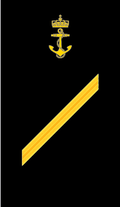
|

|

|
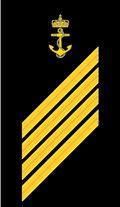
|
| Menig | Ledende menig | Visekonstabel | Ledende visekonstabel | Constant | Senior constant | |
| NCOs | ||||||
|---|---|---|---|---|---|---|
| OR5 | OR6 | OR7 | OR8 | OR9 | ||
| Hæren |

|

|

|

|
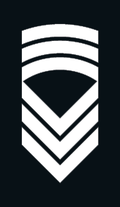
|
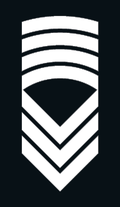
|
| Sersjant | Sersjant 1st class | Oversersjant | Stabssersjant | Kommandérsersjant | Serjant major | |
| Luftforsvaret |

|

|

|

|

|

|
| Sersjant | Seniorsersjant | Vingsersjant | Stabssersjant | Kommandérsersjant | Serjant major | |
| Sjøforsvaret |

|
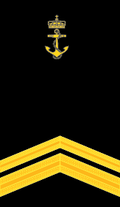
|
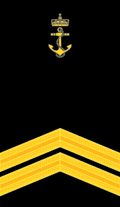
|

|

|

|
| Kvartérmester | Seniorkvartérmester | Skvadronsmester | Flotile semester | Orlogsmester | Flagmester | |
| Officers | ||||||||||
|---|---|---|---|---|---|---|---|---|---|---|
| OF1 | OF2 | OF3 | OF4 | OF5 | OF6 | OF7 | OF8 | OF9 | ||
| Hæren |

|

|

|

|

|

|

|

|

|

|
| Fenrik | Løytnant | Captain / Rittmester | major | Colonel Løytnant | Colonel | Brigadér | Major general | Generalløytnant | general | |
| Luftforsvaret |

|

|

|

|

|

|

|

|

|

|
| Fenrik | Løytnant | Captain | major | Colonel Løytnant | Colonel | Brigadér | Major general | Generalløytnant | general | |
| Sjøforsvaret |

|

|

|

|

|

|

|

|

|

|
| Fenrik | Løytnant | Captain | Orlogskaptein | Kommandørkaptein | Commander | Flag Commandor | Admiral | Visa admiral | admiral | |
Trivia
The armed forces introduced a Meatless Monday (Monday) in November 2013 , on which only meat-free food for the troops is given. In the press releases it is emphasized that the measure does not serve to save money, but to “fight against climate change ”.
literature
- David Miller: The world's naval forces . Bechtermünz Verlag, Augsburg 1998, ISBN 978-3-8289-5333-8 (English: The world's navies . Translated by Wolfram Schürer).
Web links
- Official website of the Norwegian Armed Forces. Retrieved June 16, 2013 .
- Official website of the Norwegian Armed Forces. Retrieved June 16, 2013 (Norwegian).
- Overview of the Norwegian military. In: GlobalDefence.net. July 7, 2008. Retrieved August 25, 2017 .
- Overview of the Norwegian military. In: army-guide.com. Retrieved June 16, 2013 .
- Jegertroppen i Forsvarets spesialkommando (Norwegian)
Individual evidence
- ↑ a b c "Defense Expenditure of NATO Countries (2012-2019)", Press Release Communique PR / CP (2019) 069, NATO Public Diplomacy Division, June 29, 2019 (PDF, 128kB)
- ^ Compulsory military service. Norwegian Armed Forces, January 16, 2012, archived from the original on November 5, 2013 ; accessed on April 27, 2013 (English).
- ↑ Norway introduces conscription for women. DiePresse.com , June 14, 2013, accessed June 16, 2013 .
- ↑ Marie Melgård, Karen Tjernshaugen: Stortinget vedtar verneplikt for kvinner 14 June . In: Aftenposten . April 21, 2013, ISSN 0804-3116 (Norwegian, online [accessed April 27, 2013]).
- ^ Norwegian women opposed to gender-neutral military service. The Norway Post, April 23, 2013, accessed April 27, 2013 .
- ↑ diepresse.com - Norway introduces conscription for women. Article dated October 14, 2014, accessed October 14, 2014.
- ↑ Forsvarets Military organisasjon (Military Organization of the Armed Forces). Forvaltningsdatabasen (Norwegian government database), accessed October 30, 2017 (Norwegian).
- ↑ Norwegians order 20 dingoes (HNA.de, November 1, 2010)
- ↑ Equipment Facts - Sea. Norwegian Armed Forces, January 16, 2012, archived from the original on February 3, 2015 ; accessed on April 27, 2013 (English).
- ↑ Jennifer Smith: Norwegian army goes vegetarian as it goes to war against climate change by cutting 'ecologically unfriendly' foods. In: dailymail.co.uk. Daily Mail , November 20, 2013, accessed January 18, 2016 .
- ↑ Heather Saul: Norwegian army placed on strict vegetarian diet. In: independent.co.uk. The Independent , November 30, 2013, accessed January 18, 2016 .
